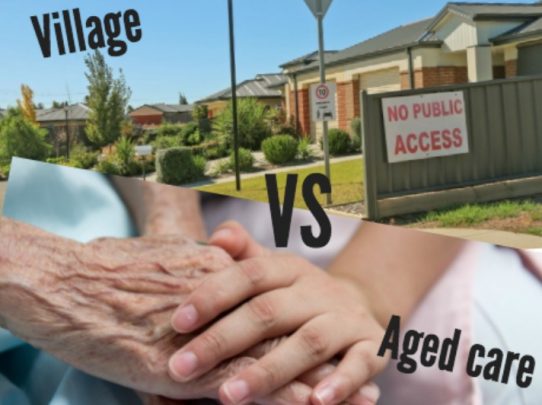The differences between aged care and retirement villages

All too often people get confused about the differences between aged care and retirement villages.
Mention moving to a retirement village to some people, and they instantly picture a nursing home.
But that’s often far from the truth, in fact most retirement villages are independent living.
So, what are the differences between aged care and retirement villages?
Well, there are a few key differences.
Aged care facilities such as nursing homes are regulated by the Federal Government, and a person needs an Aged Care Assessment to become a resident.
A retirement village on the other hand is units or apartments, regulated by state governments. They are not actually accredited to provide residential aged care.
Aged care facilities/nursing homes
The care you receive in an aged care facility or nursing is subsidised by the Federal Government. If you live in an aged care facility you may pay Accommodation Payments, unless you don’t have the assets to pay for them. That means if you can’t care for yourself at home and don’t think you can afford a nursing home or aged care, there are options for you. If you can afford it, you pay a bond (known as an Accomodation Deposit) which will be returned to you or your estate when you leave the facility (or die).
Read more: How you can negotiate the cost of aged care
Retirement villages
Unlike an aged care facility, a retirement village doesn’t provide full time support and health care to residents. A retirement village can bring in support services to assist if you need them, but the majority of people living in retirement villages are able to care for themselves and you usually pay separately for those services. The only way to enter a retirement village is to buy or enter a lease-style agreement, which will require upfront fees like buying a home. Unlike an aged care bond, retirement villages can keep as much as 30 to 40% of what you paid for the unit when you choose to move or sell.
Read more: Busting the ‘myths’ of retirement living
If moving into a retirement village or aged care facility doesn’t interest you, then there is another alternative – supported residential service.
Supported residential service
A supported residential service provides you with care and support, but is not an accredited aged care provider. They are regulated by state governments, although they’re not available in every state. If you just need a little bit of assistance with your day to day life or some short term care after an accident, surgery or illness, then this option might be good for you. Unfortunately, the cost of a supported residential service is not subsidised by the government, but if you’re a pensioner you can get some rental assistance if you’ve staying in a supported residential service facility. Like an aged care facility, many supported residential service facilities have nursing and care staff on site.
So, how do you feel tell the difference between them?
Well, Margaret Harrison from Signpost Aged Care Services has come up with a list of tips to help people people make the distinction.
- Look at the kitchen. If your unit/home has a fully functional kitchen, then chances are it’s a retirement village – not an aged care facility.
- Accommodation payments. If the facility you’re looking at moving into doesn’t require an accommodation payment or bond, then chances are it’s a supported residential service not an aged care facility. While some supported residential services do have bonds, they’re not guaranteed like the bond in an aged care facility.
- Do your research. If you hop onto the government’s My Aged Care website (www.myagedcare.gov.au) you can do some research on the facility you’re looking at moving into. Just used Find a Service, Aged care homes to search for the facility. If it’s not listed on the website as ‘Commonwealth Government subsidised’, then it’s not an aged care facility.
- Ask if you’re confused. When looking at a facility to move into, just ask the management what kind of facility it is. Just ask whether it’s a retirement village, aged care facility or supported residential service if you’re confused.
Now you know the differences, the big question is – what one works for you?
According to Harrison, each of the three living options is appropriate depending on your situation.
“There are good and not so good providers of each type of accommodation,” she said.
“It is important to understand what a place is so that you know what a resident can expect both financially and in terms of the care that is provided.”
Read more: Questions should ask before moving into a retirement village








 Proudly Australian owned and operated
Proudly Australian owned and operated